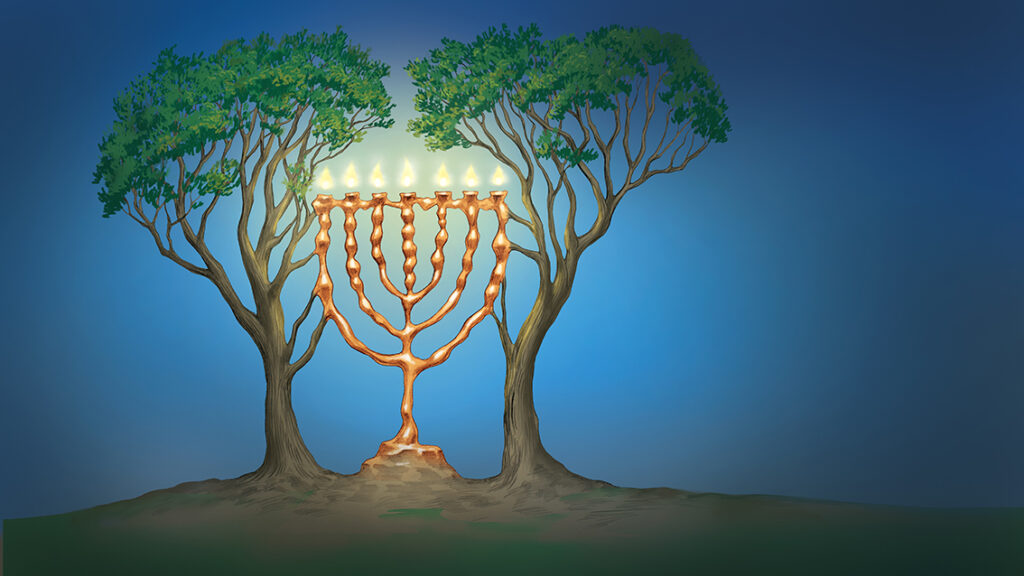
6. The Two Witnesses
Dan 12:11-12, Zech 4:1-14 , Rev 11:3-4
In Revelation 11, the apostle John described two witnesses who will testify against the work of the beast. The Greek text literally says, “I will give two witnesses of Me, and they will prophesy for 1,260 days,”Rev 11:3 which we know are years.
John said these two witnesses were two olive treesRev 11:4 and two lampstands. The two olive trees are from the Book of Zechariah.Zech 4:11 They are two olive trees that drip of the oil of the Spirit of Christ. Trees represent the righteous in the kingdom of God.
Of course, there were more than two witnesses for Christ over these 1,260 years, but Jesus said the Law required only two witnesses.
In the last Chapter of the Book of Daniel, we find two witnesses.
From the time the daily sacrifice is taken away and the abomination of desolation is set up, there shall be 1,290 days.
Daniel 12:11
Daniel wrote, “From the time the daily sacrifice is taken away and the abomination of desolation is set up, there shall be 1,290 days. Blessed is he who waits and comes to the 1,335 days.”Dan 12:11-12
The 1,290 days were the “time, times, and half a time,” that came to an end in 1471, when the Hussites broke free from the power of the beast, through the preaching of Jan Huss who was burned at the stake in 1415.
The words “Blessed is he who waits and comes to the 1,335 days,” brings us another 45 years to the year 1516.
Before his death in 1485, an imprisoned monk named Johannes Hilten, said, “Another one … will come in A.D. 1516, who will destroy you. Neither will you be able to resist him.”1
The young monk who would come in 1516 was more blessed than Jan Huss because he would succeed without any violence against him.
John said there were two olive trees and two lampstands. The meaning of lampstands was explained in the First Chapter of Revelation. Jesus said the seven churches of Asia were seven lampstands.Rev 1:20 The two lampstands of Revelation 11 are the two churches established by the two olive trees.
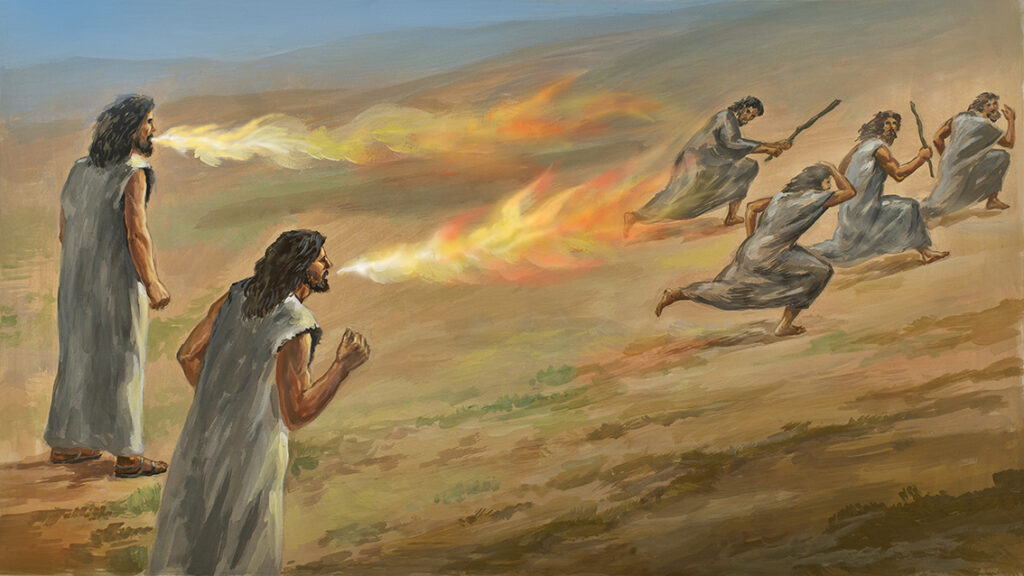
7. Fire flows out of their mouth
Dan 2:34, Isa 28:16, Rev 11:1-13
Daniel said the beast would be shattered by a stone cut out without human hands. Isaiah told us that the stone was Christ: “Behold, I am laying in Zion a stone, a tested stone, a costly cornerstone for the foundation, firmly placed. He who believes in it will not be disturbed.”Isa 28:16
The two witnesses shattered the power of the beast when they preached against the corruption of the Catholic Church.
John said, “Fire flows out of their mouth and devours their enemies; if anyone wants to harm them, they must be killed in this way.”Rev 11:5 The prophet Jeremiah told us that this fire was the Word of God.Jer 23:29
John continued his prophecy: “They have the power to shut up the sky in the days of their prophesying.”Rev 11:6 The Spirit of Christ was the rain poured out by the two witnesses after 3 ½ years, or 1,278 days as years, just as Elijah prayed that it not rain and after 3 ½ years he prayed for rain, and rain watered the earth.James 5:17-18 Then the saints began to rebuild the Temple of God, as prophesied by Zechariah, “not by might, nor by power, but by My Spirit,”Zech 4:6 which the Targum told us was the Spirit of Christ, the Word.
Fire flows out of their mouth and devours their enemies; if anyone wants to harm them, they must be killed in this way.
Revelation 11:5
The two witnesses freed the saints from Mystery Babylon, which John called “the great city mystically called Egypt.”Rev 11:8 They had “the power to strike the Earth with a plague.”Rev 11:6
In the Book of Revelation, plagues are spiritual. The Earth represents the people of the world.
The first plague that Moses and Aaron made happen in Egypt involved turning water into blood. John said the two witnesses also had “the power to turn the waters into blood.”Rev 11:6 The same plague is found in the second bowl of wrath: the angel poured his bowl into the sea, and it became blood, and every living thing died.Rev 16:3 In the Book of Revelation, the “sea” represents salvation and baptism, and blood represents the spiritual death of those who are baptized in the kingdom of the beast.
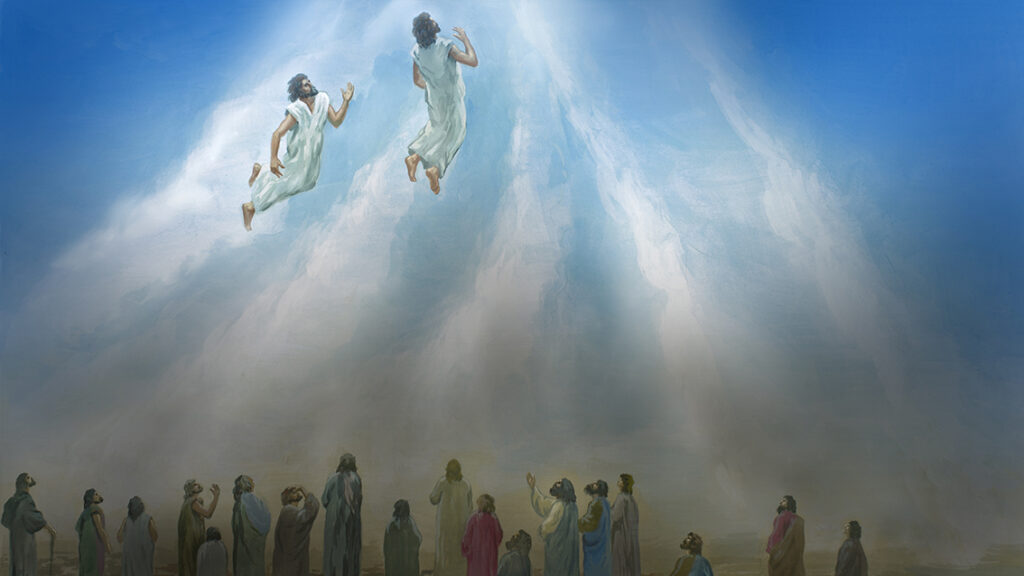
8. Three and a Half Days
After Jan Huss was burned at the stake in 1415, all of Bohemia was outraged, and an army of Hussites continued his testimony.
In 1467, a devout group of Hussites called the Unity of the Brethren mustered the courage to declare its separation from the Catholic Church, and they selected three brothers as the ministers of their new church. These three new ministers rebaptized all the brethren in the meeting.
Fearing that the common people would not accept the new ministers without proper apostolic authority, the brethren asked the Waldensian bishop Stephan to ordain them. The Waldensians believed that his succession as a bishop could be traced back to the time of the apostles.2
John said that “when [the two witnesses] have finished their testimony, the beast that came up from the abyss will make war with them and overcome them and kill them.”Rev 11:7
After three and a half days they stood on their feet, and great fear fell upon all who watched them.
Revelation 11:11
John said they would be killed in full view of all, and “those from the peoples and tribes and tongues and nations will look at their dead bodies for three and a half days.”Rev 11:9 On August 19, 1467, Bishop Stephan was burned at the stake in Vienna,3 and the Moravian brethren were scattered and hunted like deer in the forest of Bohemia.4 The grace of God came when Archbishop Jan Rokycana died on February 22, 1471. One month later, King George Prodebrady died, and the opposition stopped. George Prodebrady was succeeded by Vladislaus. All the imprisoned members of the brethren were set free, public services began, and the new independent church prospered. This occurred three and a half days, or years, after the death of Bishop Stephan.
John said, “After three and a half days they stood on their feet, and great fear fell upon all who watched them.”Rev 11:11
This ended the “time, times, and half a time” in the hand of the beast: 3 ½ years, 1,278 days as years from the time that the bishop of Rome exalted himself as high as Christ.
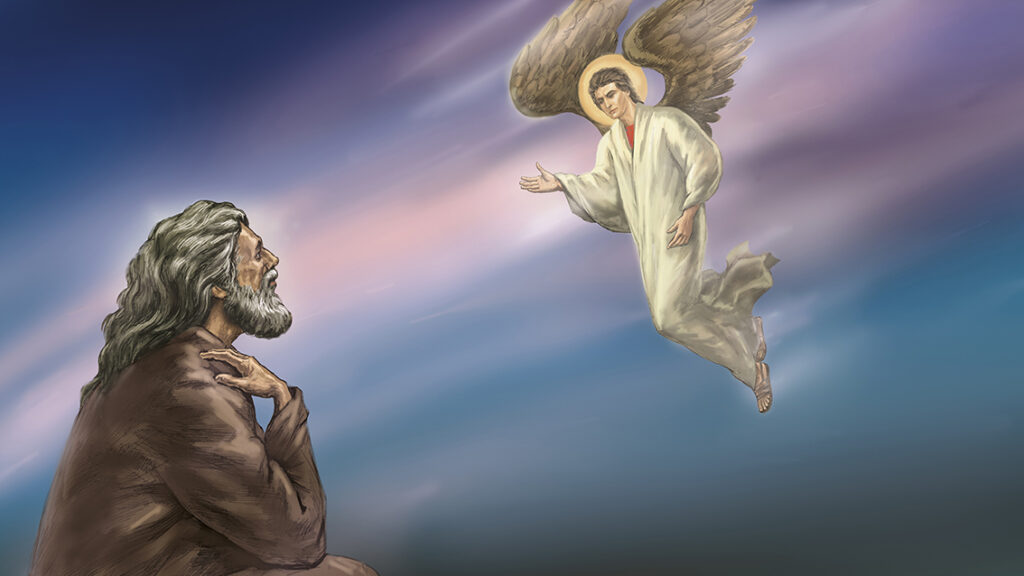
9. One Thousand Years
Dan 8:9-14, Dan 12:5-13, Zech 14:2, Rev 20:4
John said that the martyrs who did not worship the beast would rise and reign with Christ for 1,000 years.
It seems that some might have already understood that the return of Christ was at least 1,000 years away. Peter said, “Do not let this one fact escape your notice. With the Lord, a day is as a thousand years … the Lord is not slow about His promise.”2 Pet 3:8-9
This “thousand years” came from the Book of Daniel.
In Daniel 12, an angel described the corruption of the Kingdom of Heaven over “a time, times, and half a time.” In Verse 11, this was explained as 1,290 days. That is 43 months of 30 days on the Jewish lunar calendar, from the time that the abomination of desolation was set up.
For 2,300 days, then the sanctuary will be cleansed.
Daniel 8:14
In Daniel 8, an angel described the sin that caused desolation. In Verse 13, another angel, a holy one, asked, “‘How long will the vision be concerning the daily sacrifice and the transgression of desolation, and the giving of both the sanctuary and the host to be trampled underfoot?”
The angel said to Daniel, “For 2,300 days, then the sanctuary will be cleansed.”Dan 8:14
The corruption of 1,290 days and the cleansing of the sanctuary after 1,010 days are the two time periods described in the Book of Revelation. These 1,010 days are the 1,000 years when the martyrs reign with Christ, as described in Revelation 20. The blood of the martyrs speaks for the truth and cleanses the Kingdom of Heaven for 1,000 years.
The same time periods were explained by the prophet Zechariah. He said, “Half of the city will go into captivity.”Zech 14:2 We know that the saints were in captivity for 1,290 days. These represent half of the days of the Kingdom of Heaven.
10. The First Resurrection
The First Resurrection is the resurrection of the martyrs who did not worship the beast.
“Those who had been beheaded because of their testimony of Jesus and because of the word of God, and those who had not worshiped the beast or his image and had not received the mark on their foreheads, they came to life and reigned with Christ for a thousand years.”Rev 20:4
They heard a loud voice saying, “Come up here!” They went up into heaven in the cloud, and their enemies saw them.
Revelation 11:12
Thousands of saints were killed in the papal inquisitions of the Middle Ages, and thousands more were killed during the Reformation. The earliest Protestants, the Waldensians, were burned at the stake in the 12th and 13th centuries. In 1198, Pope Innocent III declared, “Anyone who attempts to construe a personal view of God that conflicts with Church dogma must be burned without pity.”5 Many, even bishops, who did not believe that the bread and wine consecrated during the mass became the physical body and blood of Christ were burned at the stake, and many others were drowned because they tried to baptize through immersion in rivers.
The apostle John said that the great harlot was “drunk with blood of the saints.”Rev 17:6
In 1467, after the Moravian brothers declared their independence from the pope, they were hunted in the woods of Bohemia for three and a half years. Then, in 1471, their oppressors, Archbishop Jan Rokycana and King Prodebrady, died. This ended the “time, times, and half a time” and marked the start of “the First Resurrection,”Rev 20:5 the reign of the martyrs with Christ for 1,000 years.
John said, “They heard a loud voice saying, “Come up here!” They went up into heaven in the cloud, and their enemies saw them.”Rev 11:12 The Hussite martyrs ascended straight to heaven and began the 1,000-year reign of the martyrs with Christ. Their blood speaks for the truth for 1,000 years.
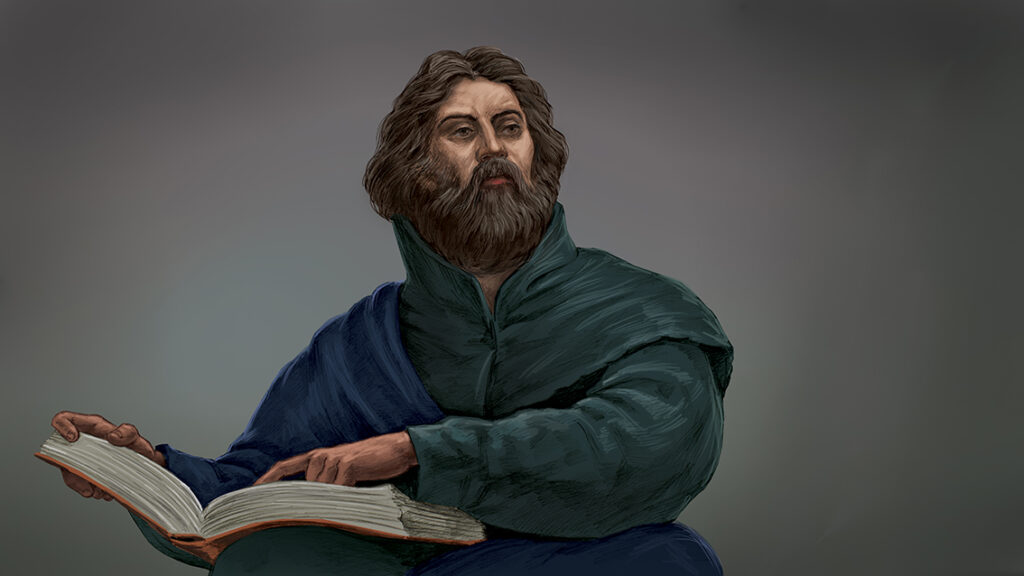
11. The Prophecies of Martin Luther
Martin Luther is often identified as the founder of the Reformation, and his coming fulfilled several prophecies.
Most significantly, he fulfilled the prophecy of the two olive trees and the two witnesses in Zechariah, Daniel, and the Book of Revelation. The Angel said, “Blessed is he who waits and comes to 1,335 days.”Dan 12:12 Adding 45 days, or years, from the end of the “time, times, and half a time” brings us to the year 1516, when Martin Luther first challenged the authority of the papacy in a public debate. In his famous Reformation history, Jean-Henri Merle d’Aubigné said, “This disputation made a great noise, and it has been considered the beginning of the Reformation.”6
Both Jan Huss and Martin Luther understood themselves as two witnesses who spoke against the beast. In his famous debate with Johann Eck, in 1519, Martin Luther declared, “I am a Hussite.”
Blessed is he who waits and comes to 1,335 days.
Daniel 12:12
The 1530 Apology of the Augsburg Confession of the Lutheran Church claimed that 1516 was the start of the Reformation. It was the fulfillment of a prophecy by a monk named Johannes Hilten, which he recorded in his commentary on the Book of Daniel. Hilten was imprisoned in a Franciscan convent in Eisenach, only a short distance from Luther’s birthplace.
Martin Luther is most famous for the 95 theses he nailed onto the door of the Wittenberg Church on October 31, 1517. He preached that salvation was by faith and attacked the sale of indulgences, which were payments for the forgiveness of sins.
In fact, however, Jan Huss protested against indulgences 100 years earlier than Martin Luther did. The Lutherans believed that Martin Luther was the fulfillment of the prophecy of Jan Huss, who said to his executioner, “Today you burn a goose, but in one hundred years a swan will arise, which you will prove unable to boil or roast.” Many pulpits in Lutheran churches are in the shape of a swan to commemorate this prophecy of Jan Huss.

12. They Overcame by the Blood of the Lamb
Matt 16:19, John 20:22-23, Acts 2:38, Rev 12:11
In the dark ages, the Catholic Church began a belief in purgatory: a temporary hell where one must pay for every unremitted sin. It also developed a system of indulgences that were guaranteed to shorten one’s stay in purgatory.
These indulgences were signed by the Pope and could be purchased or earned by participating in Church activities.
The belief in the Pope’s authority to grant the remission of sins was based on Jesus’ statement to Peter, “I will give you the keys of the kingdom of heaven.”Matt 16:19
Jesus breathed the Holy Spirit into His disciples, saying, “He whose sins you remit, they are remitted.”John 20:22-23 On the Day of Pentecost, Peter opened the gates of heaven when he told everyone to be baptized for the remission of their sins.Acts 2:38
The Pope claimed that he had the keys to heaven as the bishop of Rome.
they overcame by the blood of the Lamb, and the word of their testimony.
Revelation 12:11
It was this authority, that Martin Luther protested in his 95 theses of October 31, 1517.
In Theses 26, he said: “The pope does very well when he grants remission to souls in purgatory, not by the power of the keys, which he does not have, but by way of intercession for them.”
In the spring of 1518, Luther debated another 28 theses in Heidelberg, where he brought the message of salvation by grace through faith.
Thesis 26 said, “The law says, »do this«, and it is never done. Grace says, »believe in this«, and everything is already done.”
With Paul’s message of salvation by faith, Martin Luther brought the theology that liberated Europe from the power of the beast.
In his 1535 commentary on Galatians, Martin Luther wrote “[Christ] might have satisfied for all the sins of the world by only one drop of His blood…” Luther emphasized that righteousness comes by faith—to find salvation through works, was to deny, blaspheme and spit on Christ.
The Apostle John said, “they overcame by the blood of the Lamb, and the word of their testimony.”Rev 12:11
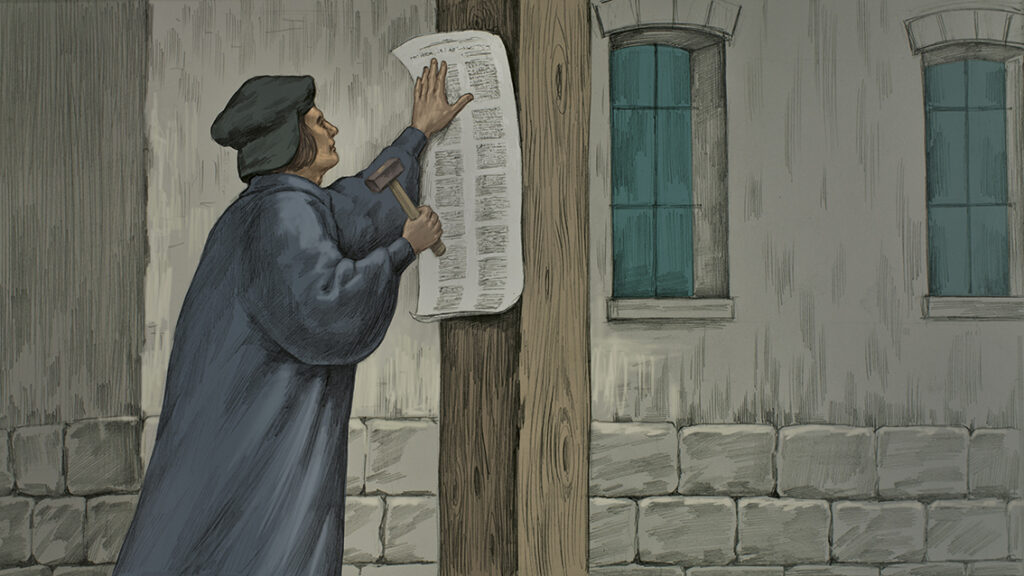

- Apology of the Augsburg Confession, 27:3 (Of Monastic Vows ↩︎
- Mike Atnip, The Birth, Life, and Death of the Bohemian Revival, pg 72-73 ↩︎
- Joseph Muller, Geschichte Der Bohmischen Bruder, Vol 1, pg. 135 ↩︎
- Mike Atnip, The Birth, Life and Death of the Bohemian Revival, pg 79 ↩︎
- Pope Innocent III, 1198, Papal Bull ↩︎
- History of the Reformation in the Sixteenth Century, Book 2, Chapter 9, pg 239 ↩︎
